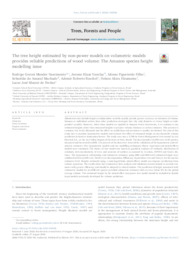The tree height estimated by non-power models on volumetric models provides reliable predictions of wood volume: The Amazon species height modelling issue.
The tree height estimated by non-power models on volumetric models provides reliable predictions of wood volume: The Amazon species height modelling issue.
Author(s): NASCIMENTO, R. G. M.; VANCLAY, J. K.; FIGUEIREDO FILHO, A.; MACHADO, S. do A.; RUSCHEL, A. R.; HIRAMATSU, N. A.; FREITAS, L. J. M. de
Summary: Allometries that include height as independent variable usually provide greater accuracy on estimates of volume, biomass or individual carbon than other prediction strategies that rely only diameter at breast height as independent variable. However, when these models are applied in Amazon Forest Inventories, it is common to use estimated heights rather than measured heights to prepare volume, biomass or carbon estimates. This practice is common, but rarely discussed and the effect on predictions and precision is usually overlooked. The aim of this study was to examine hypsometric models and evaluate the effect of estimated height on merchantable volume prediction in Eastern Amazonian forests. The study area was a 3,786 ha Forest Management Unit owned by Jari Florestal S.A., in the Jari Valley Region of the State of Pará, Brazil. The data includes 16,099 trees of 25 species, measured and harvested in 2006. Ten percent of the data were reserved for validation of the hypsometric and volumetric estimates. Five hypsometric models and two modelling techniques (linear regression and mixed-effects model) were examined. The choice of best model was based on graphical analyses of residuals, distribution of residuals, heteroscedasticity of error and presence of outliers as assessed by h-values, DFFITS and Cook's distance. The hypsometric relationship and volumetric estimates using DBH and DBH with estimated height were validated with Graybill's test, Theil's error decomposition, Efficiency, Equivalence test and Tukey's test for species estimates level. Heights estimated using a semi-logarithmic mixed-effects model can improve predictions from volume equations. The results show that exploratory data analysis and validation process helped to provide estimates with greater efficiency and should be adopted in related studies. The prediction of height associated with volumetric models for six different species provided volumetric estimates with an error below 5% for the global average volume. The estimated height by the mixed-effect non-power law model should be included in double input models previously developed for volume prediction.
Publication year: 2020
Types of publication: Journal article
Unit: Embrapa Eastern Amazon
Keywords: Floresta, Floresta Tropical, Inventário Florestal, Madeira
Observation
Some of Embrapa's publications are published as ePub files. To read them, use or download one of the following free software options to your computer or mobile device. Android: Google Play Books; IOS: iBooks; Windows and Linux: Calibre.
Access other publications
Access the Agricultural Research Database (BDPA) to consult Embrapa's full library collection and records.
Visit Embrapa Bookstore to purchase books and other publications sold by Embrapa.

